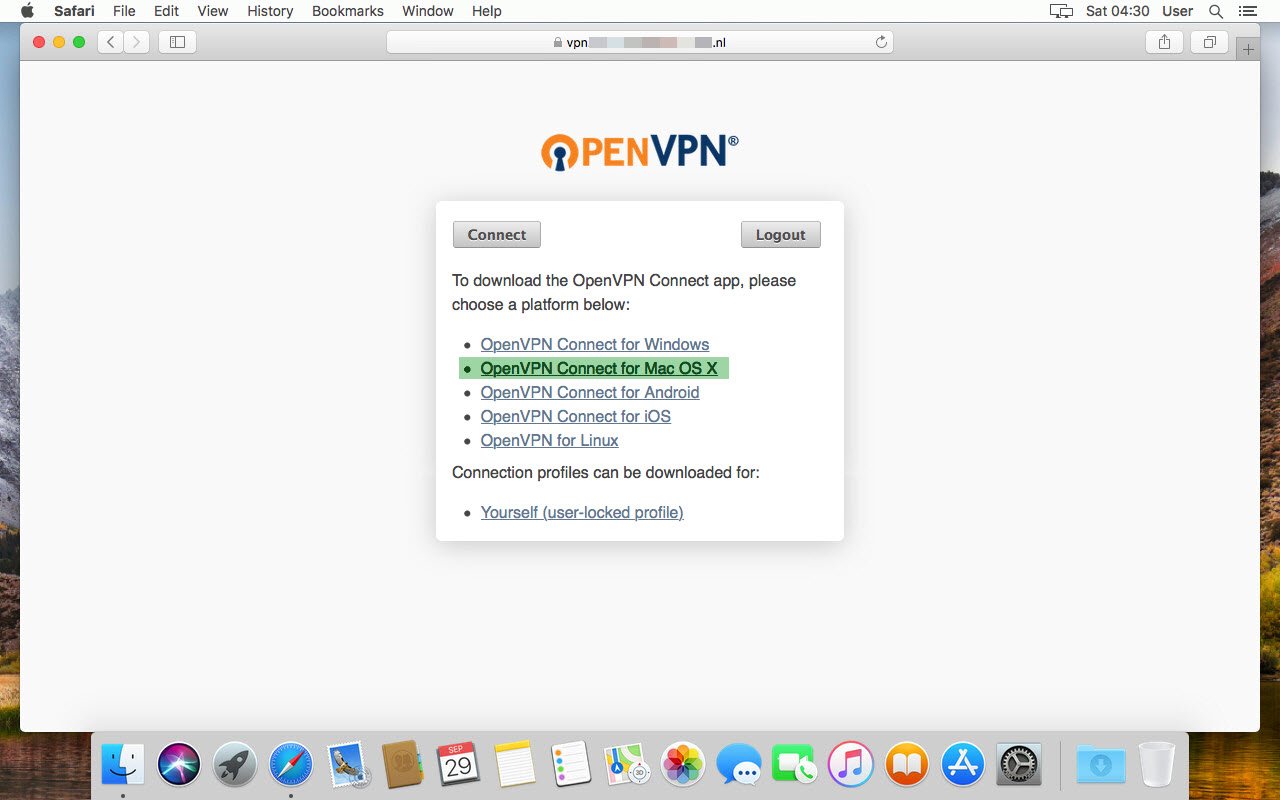Vpn Client For Mac Os
|
- Cisco Anyconnect Vpn Client For Mac Os X
- Checkpoint Vpn Client For Mac Os X Download
- Openvpn Client Mac
- Osx Vpn Clients
Give feedback
Follow these steps to connect your Mac OS X 10.10.x and above to the UCSD virtual private network (VPN).
In the right place? If you only need to access common campus Web sites or remote desktop computing, use the VPN EasyConnect option. See instructions in Virtual Private Networks at UCSD.
Notes:

Shimo is the first VPN client for Mac, which just works and which is very easy to use. Also, it is a savior, because it supports PPTP VPN on macOS Sierra, High Sierra and Mojave, in contrast to Apple’s built-in VPN client. Mac users interested in Vpn client for mac 10.6.8 generally download: Hotspot Shield 3.4 This version includes support for up to 5 Macs/PCs and 5 iOS devices for one year.
- You must log into your computer with administrator rights.
- You need your Active Directory (AD) username and password. If you don't remember your AD username or password, you can either reset it at https://adweb.ucsd.edu/adpass/ or contact your department's systems administrator.
- Computer must be running 10.10.x and above to use the Cisco AnyConnect Client. Older operating systems are no longer supported.
Cisco Anyconnect Vpn Client For Mac Os X
MacOS Big Sur Advisory:AnyConnect 4.9.04xxx leverages the System Extension framework available in macOS 11 (Big Sur). This
differs from past AnyConnect versions, which rely on the now-deprecated Kernel Extension framework. This is the minimum version required to run AnyConnect on macOS 11. Read the documentation.
1. Uninstalling the old client
- To uninstall older versions follow these steps (This will require a computer restart)
- Go to your Applications folder
- Locate and double-click on the Cisco folder
- Double-click on Uninstall AnyConnect
- Click Uninstall
- Enter your computer's administrator password
- You will then see a message saying that, 'AnyConnect has been uninstalled'.
- Click Close
- Restart your computer
- Continue with step 2
2. Download the UCSD VPN AnyConnect client for Intel
- Installing Pulse Secure on macOS / OS X This article covers how students, faculty, and staff install the Pulse Secure VPN client on Mac OS X 10.13 or macOS 10.14 and higher.
- The Barracuda VPN Client for macOS features all popular and strong encryption algorithms such as AES256 or 3DES, as well as other popular authentication methods such as X.509 certificate authentication. For advanced users, it is possible to use the VPN Client without the GUI on the command line.
- Download the VPN AnyConnect client for Intel (login required).
- Note: Minimum MacOS for this version is 10.13 (only 64-bit is supported from 10.15 and later)
- Support for 10.13 will end in November
- Save the client to your desktop.
- After the download completes, double-click the anyconnect-macos-4.9.03047-core-vpn-webdeploy-k9.pkg installation file. The AnyConnect icon shown below will appear on your desktop.
- Double-click the AnyConnect drive image.
3. Run the installation package
- Double-click the AnyConnect file inside of the window
Checkpoint Vpn Client For Mac Os X Download
4. Begin the installation
- Click Continue to begin the installation.
- When prompted, click Continue.
5. Accept the license agreement
- Click Continue.
- When the Software License Agreement window appears, click Agree to accept.
6. Continue the installation
- Click Continue.
- Click Install.
- If prompted, enter your Administrative (system) username and password.
7. Finish the installation
- When you see the Install Succeeded pop-up window, click Close to continue.
8. Run the AnyConnect client
Openvpn Client Mac

- Go to the Cisco folder in Applications and double-click the Cisco AnyConnect Secure Mobility Client.
9. Authenticate with UCSD VPN using DUO 2-Step Authentication
- In the first window, enter vpn.ucsd.edu in the box and click on the “Connect” button to the right
- A second window will appear. Select your desired connection profile from the Group drop-down menu:
- 2-Step Secured - allthruucsd – Route all traffic through the UCSD VPN. Use this when accessing Library resources and CMS website staging links. This is the preferred method.
- 2-Step Secured - split – Route only campus traffic through the UCSD VPN. All other traffic goes through your normal Internet provider.
- In the Username field, enter your Active Directory (AD) username
- In the Passcode field, use the following to authenticate through DUO (See Two-Step Login: VPN for further details):
- If you receive DUO push notifications on your mobile phone enter:
- yourADpassword,push
- If you receive a DUO phone call to authenticate, enter:
- yourADpassword,phone
- If you use a DUO token to generate a passcode enter:
- yourADpassword,6digitpasscodefromtoken
- If you receive DUO push notifications on your mobile phone enter:
- Click OK.
10. Disconnect
- Click the AnyConnect client icon located near the top right corner of your screen.
- Select Disconnect.
Osx Vpn Clients
To ask questions, request a service, or report an issue, contact the ITS Service Desk, (858) 246-4357 or ext. 6-HELP.
